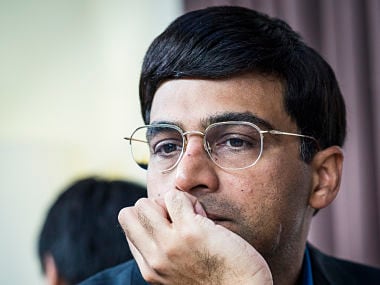Viswanathan Anand began with a cautious start when he drew his first round game against American GM Hikaru Nakamura at the Sinquefield Cup taking place in Saint Louis, United States. With well-fought games all around, three decisive games and exciting play marked the inaugural round of the third leg of the Grand Chess Tour. [caption id=“attachment_3890331” align=“alignleft” width=“380”]  Vishwanathan Anand during his first round game. Lennart Ootes[/caption] The Berlin Wall system of the Ruy Lopez opening is denoted by 1.e4 e5 2.Nf3 Nc6 3.Bb5 Nf6, followed by 4.0-0 Ne4. It has become a niggling headache for white players all around, straightaway proving to be immensely difficult to create even a complex position to play, leave alone strive for a tangible advantage with white pieces. ‘Invented’ by Vladimir Kramnik who used it en route to a brilliant match victory against Garry Kasparov in 2000 by blunting his illustrious opponent’s white preparation, the Berlin defence has become the cornerstone of black’s defence against the king pawn opening, 1.e4. And the tragedy of the times is that, even aggressive players like Nakamura choose it on an odd day when they don’t want to test a ‘white’ opponent with a reputation of being formidable in opening preparation. However, frequent use of the system has also led to white players avoiding to play against the mainlines even more frequently. Thus, the top players of the world have arrived at a scenario where majority of the games feature moves like 4.d3 against the Berlin, or white avoiding the branch completely by adopting the Guico Piano, the current ‘fashion’. But the theoretical research of those positions too have reached such a depth that, even in such offbeat lines, there almost don’t remain many possibilities for white to create aggressive schemes. It was such of those rounds of a top tournament at Sinquefield Cup on Wednesday, as two of the five games featured the Guico Piano with 3.Bc4 Bc5, while Anand went for the modest 4.d3 against Nakamura, hoping to create an original position where he could keep a strategical pull and explore for ways to play in fixed structures. Anand produced a deviation from trodden paths with 9.Bg3, denoted as a ‘Novelty’ in technical terms. And he indeed seemed to have won the supremacy for opening play when he enjoyed a minute advantage after the opening phase, when black’s pieces seemed to lack a certain freedom after 17.Re1. However, an uncharacteristic 22.g4 weakened Anand’s kingside and reduced his chances to push for a strategic advantage. Then came a mistake with 23.Ne4? after which Nakamura seemed took control of the game. When everything seemed to poise for an interesting fight and white seemed to be resigned to defence, Anand and Nakamura repeated the moves and agreed for a draw by the 30th moves. Perhaps, the beginning of a strong event and having already equalised with black pieces played a part in Nakamura’s lack of will to push forward. Armenian heavyweight Levon Aronian produced a short and sweet victory against Russian Ian Nepomniachtchi, preferring an early thrust on the kingside with 7.h4 & 8.h5, and following it up with the creative 10.Rh4. He won Garry Kasparov’s praise with a tweet.
A bloody day in Saint Louis. Must appreciate Aronian's new method for developing rooks! #SinquefieldCup https://t.co/j1ZQpNMdAL https://t.co/mIh8WBQcmW
— Garry Kasparov (@Kasparov63) August 2, 2017
Black’s insipid play resulted in Aronian wrapping the technical part of the game efficiently and winning in just 29 moves. The best clash of the round was between world championship challenger Sergey Karjakin and fellow Russian Peter Svidler. Going for a sharp and complicated play from the word go, the game became such a delight for spectators. At one point white had sacrficed an exchange and had a imposing pawn phalanx with a4-b5-a6 threatening to run down on the queenside, handling Karjakin a well deserved win. Philippines born American Wesley So, runner-up to Carlsen at the previous ‘Your Next Move’ Grand Chess Tour event at Leuven, Belgium and currently world number three with a formidable 2805 ELO rating, fell victim to the classic time pressure tragedy when he blundered on the 40 the move, the last move of the time control, and lost the game to Maxime Vachier-Lagrave. Fabiano Caruana and world champion Magnus Carlsen fought a long game from another Ruy Lopez opening and the game ended in a draw after 43 moves after near perfect play from both the sides. Results: (1st Round) Sergey Karjakin 1 - 0 Peter Svidler Maxime Vachier-Lagrave 1 - 0 Wesley So Levon Aronian 1 - 0 Ian Nepomniachtchi Fabiano Caruana ½ - ½ Magnus Carlsen Viswanathan Anand ½ - ½ Hikaru Nakamura


)




